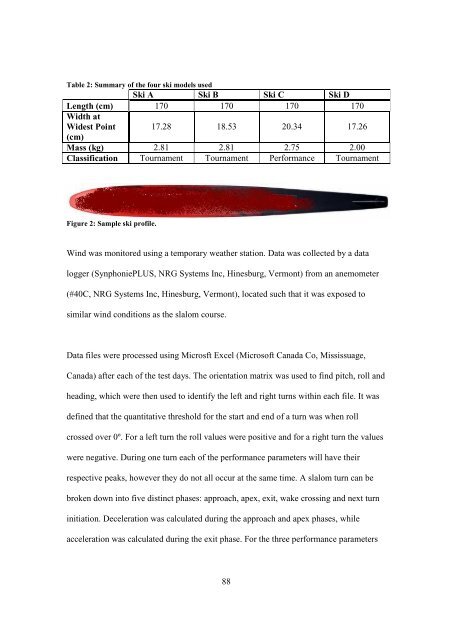Biomechanical P ... Slalom Water Skiing R1.pdf - Atrium - University ...
Biomechanical P ... Slalom Water Skiing R1.pdf - Atrium - University ...
Biomechanical P ... Slalom Water Skiing R1.pdf - Atrium - University ...
- No tags were found...
Create successful ePaper yourself
Turn your PDF publications into a flip-book with our unique Google optimized e-Paper software.
Table 2: Summary of the four ski models usedSki A Ski B Ski C Ski DLength (cm) 170 170 170 170Width atWidest Point 17.28 18.53 20.34 17.26(cm)Mass (kg) 2.81 2.81 2.75 2.00Classification Tournament Tournament Performance TournamentFigure 2: Sample ski profile.Wind was monitored using a temporary weather station. Data was collected by a datalogger (SynphoniePLUS, NRG Systems Inc, Hinesburg, Vermont) from an anemometer(#40C, NRG Systems Inc, Hinesburg, Vermont), located such that it was exposed tosimilar wind conditions as the slalom course.Data files were processed using Microsft Excel (Microsoft Canada Co, Mississuage,Canada) after each of the test days. The orientation matrix was used to find pitch, roll andheading, which were then used to identify the left and right turns within each file. It wasdefined that the quantitative threshold for the start and end of a turn was when rollcrossed over 0º. For a left turn the roll values were positive and for a right turn the valueswere negative. During one turn each of the performance parameters will have theirrespective peaks, however they do not all occur at the same time. A slalom turn can bebroken down into five distinct phases: approach, apex, exit, wake crossing and next turninitiation. Deceleration was calculated during the approach and apex phases, whileacceleration was calculated during the exit phase. For the three performance parameters88
















